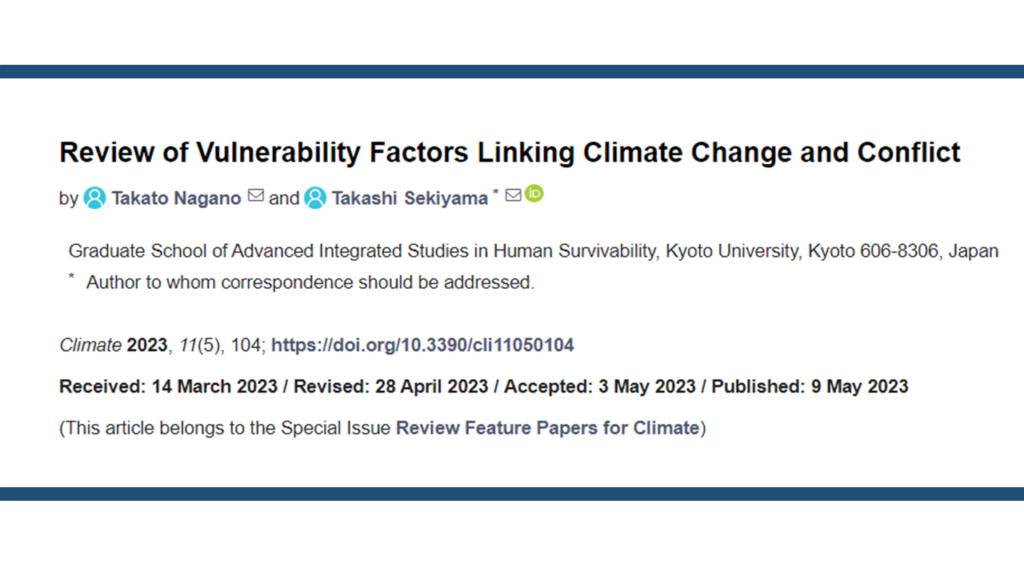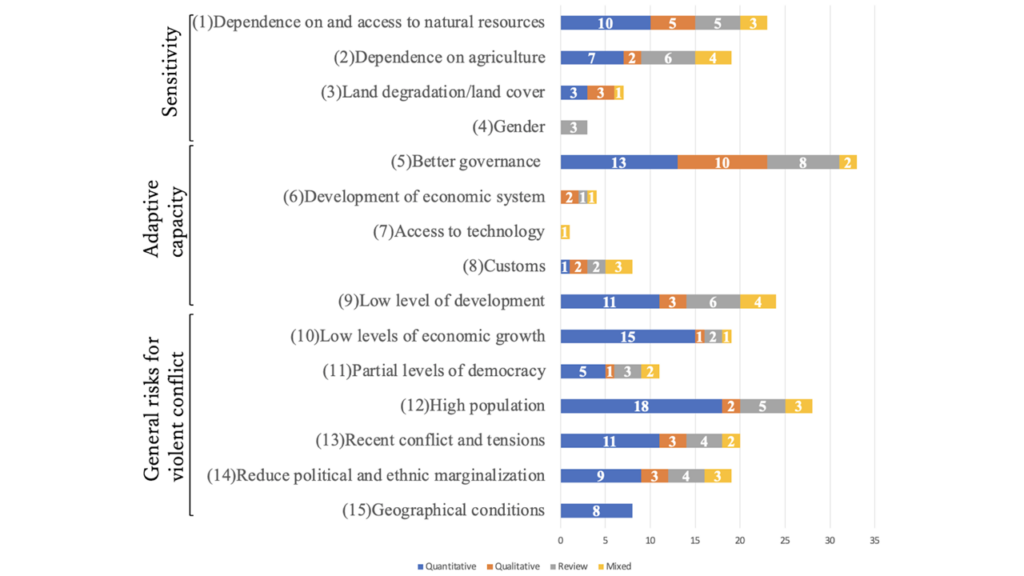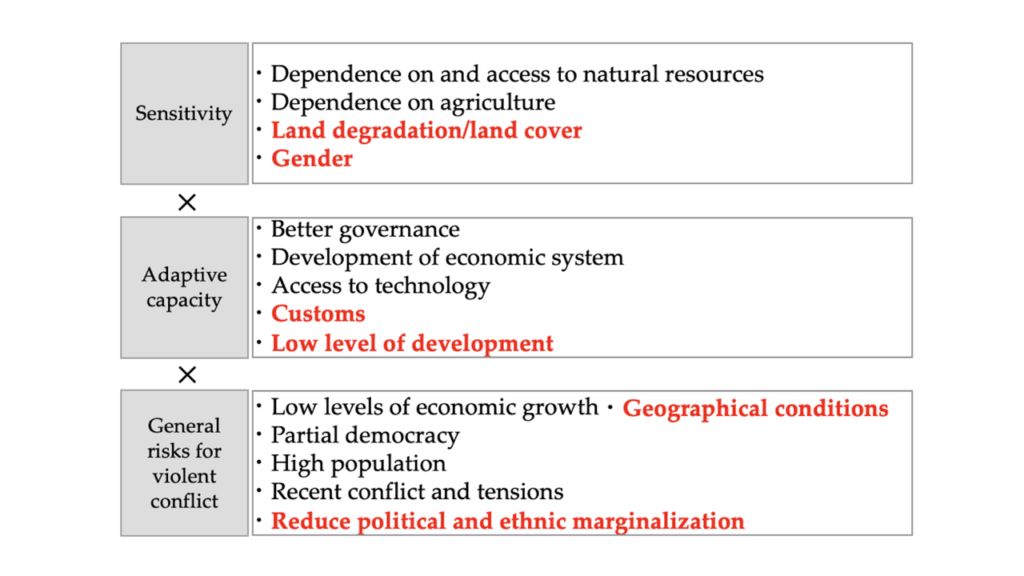
The following article by aiESG researcher Takato Nagano, reviewing the relationship between climate change impacts and conflict, was published on 9 May 2023.
[The [ibid.Review of Vulnerability Factors Linking Climate Change and Conflict]
https://www.mdpi.com/2225-1154/11/5/104
This report will explain the content of the above paper.
This study analyses the vulnerability conditions in societies where climate change impacts lead to armed conflict. There is no common understanding of the mechanisms by which climate change leads to conflict in the climate security field. The study reviewed existing papers and proposed a new framework, adding gender and geographical conditions.
background
In one of the few review papers on societal vulnerability linking climate change and conflict, Pearson & Newman (2019) proposed to understand vulnerability in terms of three dimensions: sensitivity, adaptive capacity and general conflict risk. However, given their focus on the African agricultural sector, vulnerability in other contexts is not necessarily in scope. It is also not fully clear what factors are included in these three aspects in the first place.
The link between climate change and armed conflict was first discussed in earnest in 2007, when the UN Security Council took up the issue of climate change for the first time. This study therefore conducted a comprehensive review of 53 quantitative, qualitative and mixed studies that mention vulnerability conditions in articles published between 2007 and 2022 on the link between climate change and armed conflict, in order to identify which conditions to climate change, and which conditions influence the vulnerability of individual societies to climate change.
Result.

Based on the results of the review, the figure above provides an overview of existing research on social vulnerabilities that lead to climate change leading to conflict. In total, the following 15 types of social vulnerability conditions that link climate change and armed conflict were identified in the 53 articles reviewed.
1. access to and dependence on natural resources; 2. dependence on agriculture; 3. land degradation and cover status; 4. gender; 5. good governance; 6. economic system development status; 7. access to (climate change adaptation) technology; 8. customs; 9. level of economic and social development; 10. economic stagnation; 11. non-democratic regimes; 12. high population density; 13. recent conflicts and confrontations; 14. political and ethnic marginalisation; 15. geographical conditions.
Conditions that received a particularly high number of mentions in the quantitative literature are, from the top, high population density (18 mentions), economic stagnation (12 mentions), recent conflicts and tensions (11 mentions) and good governance (11 mentions). In contrast, the vulnerability conditions that received particularly few mentions were, from the bottom, gender (0 mentions), customs (2 mentions) and land degradation/cover status (3 mentions).
Conditions that received a particularly high number of mentions in the qualitative literature were, from the top, good governance (10 mentions) and access to or dependence on natural resources (6 mentions). In contrast, the vulnerability conditions with particularly few mentions were gender (0 mentions), non-democracy (1 mention) and economic stagnation (1 mention).
Thus, the qualitative literature was less prevalent than the quantitative literature.
discussion
Two issues emerged from the review of existing research on vulnerability conditions in accordance with the existing vulnerability framework by Pearson &Newman. First, the existing vulnerability framework by Pearson & Newman may not classify vulnerability conditions correctly. Second, it fails to account for the newly identified vulnerability conditions linking climate change and conflict. To overcome these challenges, we have developed a new vulnerability conditions framework in which climate change leads to conflict. The following six points are factors proposed from the previous framework.
(i) Land degradation and land cover
(2) Gender.
(iii) Customs.
(iv) Low level of economic and social development
(v) Geographical conditions.
(vi) Political and ethnic marginalisation.

Furthermore, five directions for future research in the field of climate security were proposed. Firstly, as traditional research has been less qualitative than quantitative, there is a need to accumulate more case studies on the particular vulnerability conditions in countries and regions where climate change impacts lead to conflict. Secondly, there are cases where conflict-prone vulnerability conditions have not led to conflict or cooperation, and more research needs to be done on these cases. Third, more research needs to be done on the less-studied conditions within the existing framework and on the vulnerability conditions that could not be explained by the existing framework by Pearson & Newman. Fourth, there is a need to build on research on the interconnections between each of the vulnerability conditions, as they are not thought to lead to conflict in isolation, but interact to cause it. Finally, case studies will need to be built up on vulnerability conditions in countries and regions that are experiencing the effects of climate change but are not experiencing conflict.
This research clarifies the causal factors behind the occurrence of armed conflict and contributes to the construction of theories on the mechanisms of climate change-induced conflict. In addition to its academic significance in deepening research on climate change-induced conflict, it also has practical significance in enabling the study and formulation of effective and detailed armed conflict prevention policies, as it provides empirical evidence on climate change-induced armed conflict, which is feared to occur in the future. Particularly for regions that are vulnerable to climate change, have low climate change adaptive capacity and are at high risk of conflict, this research is a touchstone for the investigation of measures that can lead to conflict avoidance. It is hoped that the findings of this study can be used to formulate adaptation (good practices) that take into account local conditions in the direction of restructuring and transforming resource management and grassroots movements to prevent future climate change-induced armed conflicts.
These results will be incorporated into the comprehensive human rights, governance and climate change assessment services provided by aiESG.
Review of Vulnerability Factors Linking Climate Change and Conflict
Nagano, T., & Sekiyama, T. (2023). Review of Vulnerability Factors Linking Climate Change and Conflict. Climate, 11(5), 104. MDPI AG. Retrieved from http://dx.doi.org/10.3390/cli11050104




